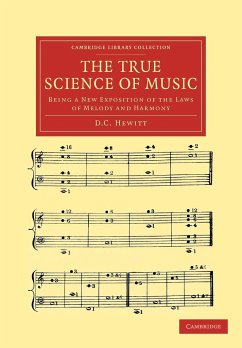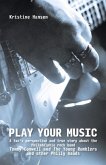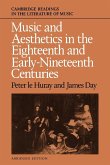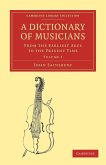D. C. Hewitt
The True Science of Music
D. C. Hewitt
The True Science of Music
- Broschiertes Buch
- Merkliste
- Auf die Merkliste
- Bewerten Bewerten
- Teilen
- Produkt teilen
- Produkterinnerung
- Produkterinnerung
First published in 1864, this work discusses aspects of the physics of music, in particular the mathematics of musical intervals.
Andere Kunden interessierten sich auch für
![Play Your Music: A Fan's Perspective and True Story about the Philadelphia Rock Band Tommy C Play Your Music: A Fan's Perspective and True Story about the Philadelphia Rock Band Tommy C]() Kristine HansenPlay Your Music: A Fan's Perspective and True Story about the Philadelphia Rock Band Tommy C9,49 €
Kristine HansenPlay Your Music: A Fan's Perspective and True Story about the Philadelphia Rock Band Tommy C9,49 €![Music and Aesthetics in the Eighteenth and Early Nineteenth Centuries Music and Aesthetics in the Eighteenth and Early Nineteenth Centuries]() Peter Le HurayMusic and Aesthetics in the Eighteenth and Early Nineteenth Centuries67,99 €
Peter Le HurayMusic and Aesthetics in the Eighteenth and Early Nineteenth Centuries67,99 €![Catalogue of the Musical Manuscripts at Peterhouse Cambridge Catalogue of the Musical Manuscripts at Peterhouse Cambridge]() Dom Anselm HughesCatalogue of the Musical Manuscripts at Peterhouse Cambridge21,99 €
Dom Anselm HughesCatalogue of the Musical Manuscripts at Peterhouse Cambridge21,99 €![The Student's Textbook Of The Science Of Music The Student's Textbook Of The Science Of Music]() John TaylorThe Student's Textbook Of The Science Of Music38,99 €
John TaylorThe Student's Textbook Of The Science Of Music38,99 €![The True Performing of It The True Performing of It]() Andrew MuirThe True Performing of It20,99 €
Andrew MuirThe True Performing of It20,99 €![The Life of Handel The Life of Handel]() Victor SchcelcherThe Life of Handel50,99 €
Victor SchcelcherThe Life of Handel50,99 €![A Dictionary of Musicians, from the Earliest Ages to the Present Time A Dictionary of Musicians, from the Earliest Ages to the Present Time]() John SainsburyA Dictionary of Musicians, from the Earliest Ages to the Present Time51,99 €
John SainsburyA Dictionary of Musicians, from the Earliest Ages to the Present Time51,99 €-
-
-
First published in 1864, this work discusses aspects of the physics of music, in particular the mathematics of musical intervals.
Hinweis: Dieser Artikel kann nur an eine deutsche Lieferadresse ausgeliefert werden.
Hinweis: Dieser Artikel kann nur an eine deutsche Lieferadresse ausgeliefert werden.
Produktdetails
- Produktdetails
- Verlag: Cambridge University Press
- Seitenzahl: 514
- Erscheinungstermin: 14. November 2011
- Englisch
- Abmessung: 244mm x 170mm x 27mm
- Gewicht: 877g
- ISBN-13: 9781108038669
- ISBN-10: 1108038662
- Artikelnr.: 34448419
- Herstellerkennzeichnung
- Libri GmbH
- Europaallee 1
- 36244 Bad Hersfeld
- gpsr@libri.de
- Verlag: Cambridge University Press
- Seitenzahl: 514
- Erscheinungstermin: 14. November 2011
- Englisch
- Abmessung: 244mm x 170mm x 27mm
- Gewicht: 877g
- ISBN-13: 9781108038669
- ISBN-10: 1108038662
- Artikelnr.: 34448419
- Herstellerkennzeichnung
- Libri GmbH
- Europaallee 1
- 36244 Bad Hersfeld
- gpsr@libri.de
Preface; Definition of terms; Introduction; 1. Sound - notion - vibration -
interval; 2. Means by which intervals may be obtained and their effects
produced, in agreement with their true ratios; 3. Description of a series
of experiments, and of the phenomena resulting therefrom; 4. The unit
sound, commonly called the grave harmonic, or generated third sound; 5.
Systems of sounds; 6. On the analysis of chords per-se; 7. Of the triune
system in respect to chords - that is, harmonic combinations, whence
proceed the first, second, and third mode; 8. Of the method of finding the
ratio of single notes and chords, which appertain to different triune
systems - and which, nevertheless, are the same upon keyed instruments, and
frequently, though not always, the same in respect to their notation; 9. Of
the second period of the development of the triune system, whence proceed
the harmonics denominated fixed chromatics, and the combinations thence
derived; 10. Nature - art; 11. Explanation of various matters preparatory
to the introduction of the musical ratiometer; 12. The musical ratiometer,
and its connexion with the triune system; 13. Analysis of musical phrases
and passages extracted from the works of the most celebrated composers, in
verification of the triune system, as being the exemplar of what is true
and natural in music; 14. Of the third period of the development of the
triune system, whence proceed the harmonics denominated serial chromatics,
and the combinations thence derived; 15. Of the great system, or system of
systems; 16. Of harmonic, basal, and tonic transitions; 17. Classification
and explanation of principal and subordinate basal transitions; 18. Rules
relating to melody, harmony, and composition; 19. On position. Why the
triune system is referred to its central and not to its sub-basis. And on
compound vibrations; 20. Accent; 21. Imitation, fugue, canon; 22. Further
remarks upon analysis and composition; 23. Analysed examples, with
strictures; 24. Further remarks upon the chord of the diminished or extreme
flat 7th. Very low and very high sounds. The number of vibrations in a
second, according to the equal temperament. Change of key. A suppositious
system of 5 bases. An ideal law of progression; 25. New tables of
logarithms, and their adaptation to musical purposes. Scale of 53 sounds in
the octave. Conclusion; Music examples; Figures and diagrams; The musical
ratiometer.
interval; 2. Means by which intervals may be obtained and their effects
produced, in agreement with their true ratios; 3. Description of a series
of experiments, and of the phenomena resulting therefrom; 4. The unit
sound, commonly called the grave harmonic, or generated third sound; 5.
Systems of sounds; 6. On the analysis of chords per-se; 7. Of the triune
system in respect to chords - that is, harmonic combinations, whence
proceed the first, second, and third mode; 8. Of the method of finding the
ratio of single notes and chords, which appertain to different triune
systems - and which, nevertheless, are the same upon keyed instruments, and
frequently, though not always, the same in respect to their notation; 9. Of
the second period of the development of the triune system, whence proceed
the harmonics denominated fixed chromatics, and the combinations thence
derived; 10. Nature - art; 11. Explanation of various matters preparatory
to the introduction of the musical ratiometer; 12. The musical ratiometer,
and its connexion with the triune system; 13. Analysis of musical phrases
and passages extracted from the works of the most celebrated composers, in
verification of the triune system, as being the exemplar of what is true
and natural in music; 14. Of the third period of the development of the
triune system, whence proceed the harmonics denominated serial chromatics,
and the combinations thence derived; 15. Of the great system, or system of
systems; 16. Of harmonic, basal, and tonic transitions; 17. Classification
and explanation of principal and subordinate basal transitions; 18. Rules
relating to melody, harmony, and composition; 19. On position. Why the
triune system is referred to its central and not to its sub-basis. And on
compound vibrations; 20. Accent; 21. Imitation, fugue, canon; 22. Further
remarks upon analysis and composition; 23. Analysed examples, with
strictures; 24. Further remarks upon the chord of the diminished or extreme
flat 7th. Very low and very high sounds. The number of vibrations in a
second, according to the equal temperament. Change of key. A suppositious
system of 5 bases. An ideal law of progression; 25. New tables of
logarithms, and their adaptation to musical purposes. Scale of 53 sounds in
the octave. Conclusion; Music examples; Figures and diagrams; The musical
ratiometer.
Preface; Definition of terms; Introduction; 1. Sound - notion - vibration -
interval; 2. Means by which intervals may be obtained and their effects
produced, in agreement with their true ratios; 3. Description of a series
of experiments, and of the phenomena resulting therefrom; 4. The unit
sound, commonly called the grave harmonic, or generated third sound; 5.
Systems of sounds; 6. On the analysis of chords per-se; 7. Of the triune
system in respect to chords - that is, harmonic combinations, whence
proceed the first, second, and third mode; 8. Of the method of finding the
ratio of single notes and chords, which appertain to different triune
systems - and which, nevertheless, are the same upon keyed instruments, and
frequently, though not always, the same in respect to their notation; 9. Of
the second period of the development of the triune system, whence proceed
the harmonics denominated fixed chromatics, and the combinations thence
derived; 10. Nature - art; 11. Explanation of various matters preparatory
to the introduction of the musical ratiometer; 12. The musical ratiometer,
and its connexion with the triune system; 13. Analysis of musical phrases
and passages extracted from the works of the most celebrated composers, in
verification of the triune system, as being the exemplar of what is true
and natural in music; 14. Of the third period of the development of the
triune system, whence proceed the harmonics denominated serial chromatics,
and the combinations thence derived; 15. Of the great system, or system of
systems; 16. Of harmonic, basal, and tonic transitions; 17. Classification
and explanation of principal and subordinate basal transitions; 18. Rules
relating to melody, harmony, and composition; 19. On position. Why the
triune system is referred to its central and not to its sub-basis. And on
compound vibrations; 20. Accent; 21. Imitation, fugue, canon; 22. Further
remarks upon analysis and composition; 23. Analysed examples, with
strictures; 24. Further remarks upon the chord of the diminished or extreme
flat 7th. Very low and very high sounds. The number of vibrations in a
second, according to the equal temperament. Change of key. A suppositious
system of 5 bases. An ideal law of progression; 25. New tables of
logarithms, and their adaptation to musical purposes. Scale of 53 sounds in
the octave. Conclusion; Music examples; Figures and diagrams; The musical
ratiometer.
interval; 2. Means by which intervals may be obtained and their effects
produced, in agreement with their true ratios; 3. Description of a series
of experiments, and of the phenomena resulting therefrom; 4. The unit
sound, commonly called the grave harmonic, or generated third sound; 5.
Systems of sounds; 6. On the analysis of chords per-se; 7. Of the triune
system in respect to chords - that is, harmonic combinations, whence
proceed the first, second, and third mode; 8. Of the method of finding the
ratio of single notes and chords, which appertain to different triune
systems - and which, nevertheless, are the same upon keyed instruments, and
frequently, though not always, the same in respect to their notation; 9. Of
the second period of the development of the triune system, whence proceed
the harmonics denominated fixed chromatics, and the combinations thence
derived; 10. Nature - art; 11. Explanation of various matters preparatory
to the introduction of the musical ratiometer; 12. The musical ratiometer,
and its connexion with the triune system; 13. Analysis of musical phrases
and passages extracted from the works of the most celebrated composers, in
verification of the triune system, as being the exemplar of what is true
and natural in music; 14. Of the third period of the development of the
triune system, whence proceed the harmonics denominated serial chromatics,
and the combinations thence derived; 15. Of the great system, or system of
systems; 16. Of harmonic, basal, and tonic transitions; 17. Classification
and explanation of principal and subordinate basal transitions; 18. Rules
relating to melody, harmony, and composition; 19. On position. Why the
triune system is referred to its central and not to its sub-basis. And on
compound vibrations; 20. Accent; 21. Imitation, fugue, canon; 22. Further
remarks upon analysis and composition; 23. Analysed examples, with
strictures; 24. Further remarks upon the chord of the diminished or extreme
flat 7th. Very low and very high sounds. The number of vibrations in a
second, according to the equal temperament. Change of key. A suppositious
system of 5 bases. An ideal law of progression; 25. New tables of
logarithms, and their adaptation to musical purposes. Scale of 53 sounds in
the octave. Conclusion; Music examples; Figures and diagrams; The musical
ratiometer.









